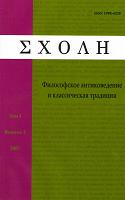Монстры эллинского мифа и их периферийные варианты
Monsters of the Hellenic Mythology and their Peripheral Counterparts
Author(s): Eka AvalianiSubject(s): Cultural Essay, Political Essay, Societal Essay
Published by: Новосибирский государственный университет
Keywords: Ancient mythology; artistic representation; gorgon; Vani; Georgia
Summary/Abstract: The article “Vani in the 4th and in the first half of 3rdI centuries BC” by D. Kacharava, D. Akhvlediani, G. Kvirkvelia (Iberia-Colchis, 3 (2007)) demonstrates recent finds in the region; the artifacts illustrated in the article, are dated from the end of early Classical times to the Early Hellenistic period and interesting in two respects; first, they are singular finds of antefixes with the representation of Medusa Gorgon, second and more interesting is the presence of “fair-cheeked Medusa’s” image in Vani archaeological context. In the Mediterranean art, the head of Medusa was very common as a decoration on shields, buildings, citadel walls, vases, and other objects. Antefixes with the representation of Medusa Gorgon images found in Vani context are stylistically close to the archaic images of Medusa Gorgon on the antefix discovered in the Acropolis of Athens, although they do not make an impression of pieces of refined art, unlike the versions from Athens. They remind us more of pieces of “craft” and peripheral versions. These discoveries are somewhat exceptional and do not have general character. Medusa iconography areal did not expand to the territory of Hellenistic Georgia, which in this case can be considered as a marginal cultural zone, where discovery of Medusa Gorgon image on abovementioned artifacts is a single fact.
Journal: ΣΧΟΛΗ. Философское антиковедение и классическая традиция
- Issue Year: VI/2012
- Issue No: 2
- Page Range: 306-322
- Page Count: 16
- Language: Russian

